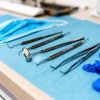
During the week, I often talk with DrBicuspid.com Editor-in-Chief Kevin Henry about several topics. Of course, over the past few weeks, the focus has been on the COVID-19 pandemic and how it is affecting the dental industry.
As practices continue to reopen and push ahead toward what will hopefully be a successful second half of the year, one of our conversations recently turned to infection control and how practices are handling that part of their business. Today, I thought I'd let you in on that conversation and some of the things we're both hearing from your colleagues, as well as some issues we believe dental practices should be avoiding.
If you're looking for solid infection control information specifically geared toward the dental industry, please check out OSAP.org and all of its resources available to help your practice.
David Rice, DDS: So, we have been talking all about personal protective equipment (PPE) for what feels like every 37 seconds for the past 10 weeks or so. Don't get me wrong: It's important, and I know you and I don't want to downplay that. However, there's another side to this story about keeping our teams and patients safe, so I think it's important for us to talk about that side as well. Kevin, what are you hearing out there?
Kevin Henry: As you just said, PPE has been at the front of everybody's mind lately, and watching how that discussion has evolved has been fascinating. But one thing I've been hearing is that there are a lot of things besides PPE that dental practices are worried about. They're also worried about restarting their water lines. They're trying to figure out other important infection control protocols in the post-COVID-19 practice that maybe weren't top of mind before all of this hit.
I know some assistants are reaching out, and they're talking to me about how they have to up their infection control game because they know their patients are going to be depending on it, as well as all those team members who are working in the practice along with them.
Dr. Rice: I love how you just framed that whole story because there are three components. We each want to keep our individual selves healthy so our families can be healthy. As a team, we want to collectively be healthy. And, for patients, health and safety are the top things they're thinking about. They're asking themselves, "Will I be safe if I come and see you?"
What are some of those other hidden infection control questions you've been hearing from dental assistants and DrBicuspid.com readers?
Henry: We've already talked about making sure that you're doing things right, but you have to drill down a little bit further and see those things in the practice that may be an infection control hazard or might be a roadblock on that road to safety for you. And these can be little things. One thing you and I talked about recently that I had never really thought about before were items like the rubber dam clamps that we have to make sure are sterilized properly. We have to make sure they're going through the infection control process properly just like everything else.
Dr. Rice: Infection control at large and our processes are extremely important. You mentioned rubber dam clamps. For those of you who haven't been using a rubber dam, welcome to 2020. It's about to become your best friend. If you want to talk about a simple, cost-effective way to stay safe on the restorative side, put a rubber dam on your patient.
Henry: I'm telling every dental assistant I can to practice rubber dam skills and become proficient at it. I think that's going to be a huge thing. However, I know what they're thinking when it comes to their patients. They're thinking their patients are not going to be able to breathe or might be claustrophobic, but I'm telling you, in this new normal where we love to talk about things that you can introduce to patients that are going to keep them safe, that's going to be a game-changer in their minds.
Dr. Rice: That's an awesome point. Patients are expecting us to keep them safe, so when we can show them that we are doing things to keep them safe and we can have that conversation with them, it is the perfect time to reintroduce the rubber dam skill that is really simple to integrate into your practice. You can explain the "why" and people will get it.
We've talked about two big things so far, but I think the third big one for me is probably just our whole instrument management system. And, again, there's a team aspect to this, and there's a patient aspect to this.
Henry: You're right. I know you and I have talked about this before, but there's an importance to communicating that infection control process. It might even include taking the patients on a quick tour of your sterilization area. As silly as that may sound, there's a peace of mind that is so important for patients right now. I think anything you can do to show them what you're doing and the steps you are taking will be helpful, and you can also remind them that these are a lot of the same steps you took back in January before we knew what COVID-19 was. I think that's a critical point in the patient's mind.
Dr. Rice: That's a great point. I am thinking about the presentation to the patient. You open up the wrapped instruments. They watch you do that, and they know they're safe. Now there's no question in their minds.
One of my favorite quotes is, "Your action speaks so loudly, I can barely hear your words." So just do the right things and make sure your patients know you're doing them as well.
Henry: Some of the most important words that I think can be said to a patient right now are, "We've done everything we can to prepare for this day and your visit."
Dr. Rice: Absolutely. We know PPE is big, but there are a lot of other things to be thinking about as well. And it takes all of it working together for good things to happen for you, your team, your patients, and your business.
The comments and observations expressed herein do not necessarily reflect the opinions of DrBicuspid.com, nor should they be construed as an endorsement or admonishment of any particular idea, vendor, or organization.



















